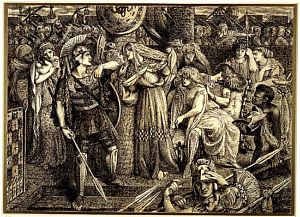
Description: DGR described the picture in the following terms: “The incident is
just before Hector's last battle. Cassandra has warned him in vain by her prophecies, and is
now throwing herself against a pillar, and rending her clothes in despair, because he will not
be detained longer. He is rushing down the steps and trying to make himself heard across the
noise, as he shouts an order to an officer in charge of the soldiers who are going round the
ramparts on their way to battle. One of his captains is beckoning to him to make haste. Behind
him is Andromache with her child, and a nurse who is holding the cradle. Helen is arming Paris
in a leisurely way on a sofa; we may presume from her expression that Cassandra has not spared
her in her denunciations. Paris is patting her on the back to soothe her, much amused. Priam
and Hecuba are behind, the latter stopping her ears in horror. One brother is imploring
Cassandra to desist from her fear-inspiring cries. The ramparts are lined with engines for
casting stones on the besiegers.” (quoted in
Marillier,
DGR: An Illustrated Memorial
, 108-9.).
Subject: Cassandra prophesying the destruction of Troy.
Copyright: © Licensed by the Trustees of the British Museum
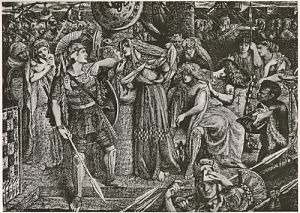
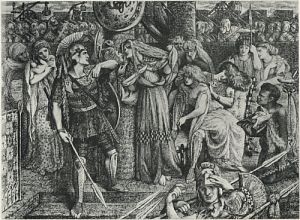
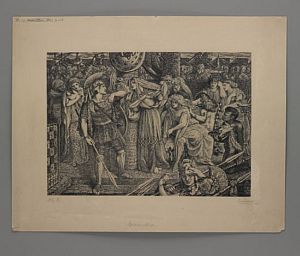
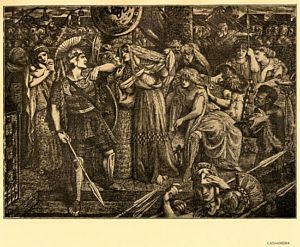
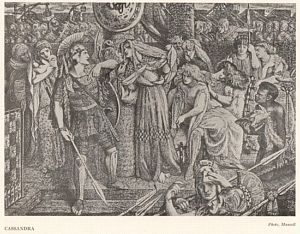
Scholarly Commentary
Introduction
DGR described this picture in dynamic terms, with Hector as the pivotal figure shown “rushing down the steps and trying to make himself heard across the noise, as he shouts an order to an officer in charge of the soldiers who are going round the ramparts on their way to battle.” But the composition is dynamic only as a tense configuration of conflicting forms and elements. The tension is epitomized in the visual relation between Cassandra and Hector, which is repeated in Hector's own posture—advancing down the steps but facing back toward Cassandra and the royal family. The picture is a series of replications of similar divergent or conflicted lines of action.
The depiction of the soldiers at the top of the drawing “going round the ramparts on their way to battle” is extremely effective pictorially. They are aligned on a single plane representing the picture's deepest spatial level; they also locate the place to which Hector is rushing. The picture's shallow space, however, as well as the representation of Hector moving toward the picture plane, totalizes the impression one receives of immobilized and pointless action.
Production History
DGR executed the drawing in 1860 and finished it late that year or very early in 1861, when he sent it to William Gillum. In 1867 he reworked and redated it. He told Charles Eliot Norton that he meant to develop the subject into a painting, but he never did (see Fredeman, Correspondence, 60.37, 69.48).
A note in the British Museum's departmental register for prints and drawings reads: “Drawn 1851-1861, retouched 1867. Purchased directly from Rossetti.” This seems to be Gillum's note. This suggestion that the drawing was begun in 1851 seems wrong, though it is difficult to explain.
Iconographic
The figure of Cassandra probably signifies DGR's understanding of the contemporary social position of the artist.
Literary
According to George Meredith, it was his poem Cassandra that inspired DGR to do his original drawing in 1861 (see Fredeman, Correspondence, 69.48, 176n). But this suggestion is somewhat problematic since Meredith said that “Rossetti is going to illustrate my Cassandra,” whereas DGR had completed the drawing long before the date of this statement (December 1861).
The pair of sonnets written for this drawing underscores the contemporary significance that DGR attached to the myth of Troy. For DGR (as for Tennyson and others of the period) the Matter of Troy involved a broadly applicable story of social doom.
Bibliography